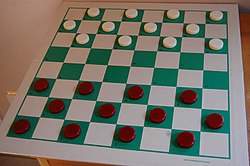Checkers (game)

A standard American Checker Federation (ACF) set: smooth red and white 1.25-inch (32 mm) diameter pieces; green and buff 2-inch (51 mm) squares
|
|
| Genre(s) |
Board game Abstract strategy game |
|---|---|
| Players | 2 |
| Playing time | Casual games usually last 10 to 30 minutes |
| Random chance | None |
| Skill(s) required | Strategy, tactics |
| Synonym(s) | American checkers Straight checkers Checkers |
English draughts (British English) or checkers (American English; see spelling differences), also called American checkers or straight checkers, is a form of the strategy board game draughts. It is played on an 8×8 chequered board with twelve pieces per side. The pieces move and capture diagonally forward, until they reach the opposite end of the board, when they are crowned and can thereafter move and capture both backward and forward.
As in all forms of draughts, English draughts is played by two opponents, alternating turns on opposite sides of the gameboard. The pieces are traditionally black, red, or white. Enemy pieces are captured by jumping over them.
The 8×8 variant of draughts was weakly solved in 2007 by the team of Canadian computer scientist Jonathan Schaeffer. From the standard starting position, both players can guarantee a draw with perfect play.
Though pieces are traditionally made of wood, now many are made of plastic, though other materials may be used. Pieces are typically flat and cylindrical. They are invariably split into one darker and one lighter colour. Traditionally and in tournaments, these colours are red and white, but black and red are common in the United States, and dark- and light-stained wooden pieces are supplied with more expensive sets. The darker-coloured side is commonly referred to as "Black"; the lighter-coloured side, "White".
There are two classes of pieces: men and kings. Men are single, uncrowned pieces. Kings consist of two men of the same colour, stacked one on top of the other. Pieces are often manufactured with indentations to aid stacking.
Each player starts with twelve men on the dark squares of the three rows closest to that player's side (see diagram). The row closest to each player is called the kings row or crownhead. The player with the darker-coloured pieces moves first.
There are two different ways to move in English draughts:
...
Wikipedia
